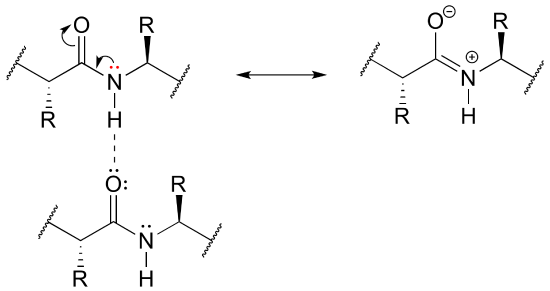P2.1:
bond a is a sigma bond formed by the overlap of an sp3 orbital on one carbon and an sp2 orbital on another carbon.
bond b is a sigma bond formed by the overlap of an sp2 orbital on one carbon and an sp2 orbital on another carbon.
bond c is a sigma bond formed by the overlap of an sp2 orbital on a carbon and an sp2 orbital on a nitrogen, combined with a pi bond formed by the overlap of a 2p orbital on a carbon and a 2p orbital on a nitrogen.
bond d is a sigma bond formed by the overlap of an sp2 orbital on a nitrogen and a 1s orbital on a hydrogen.
bond e is a sigma bond formed by the overlap of an sp2 orbital on one carbon and an sp3 orbital on another carbon.
bond f is a sigma bond formed by the overlap of an sp3 orbital on one carbon and an sp3 orbital on another carbon.
P2.2:
a)

b)
Top: the contributor on the right is minor due to separation of charge.
Middle: the contributor on the left is minor due to one carbon not having a complete octet.
Bottom: The contributors shown are roughly equivalent.
P2.5:
bond a is a sigma bond formed by the overlap of an sp2 orbital on one carbon and an sp3 orbital on another carbon.
bond b is a sigma bond formed by the overlap of an sp2 orbital on a carbon and an sp2 orbital on an oxygen, combined with a pi bond formed by the overlap of a 2p orbital on a carbon and a 2p orbital on an oxygen.
bond c is a sigma bond formed by the overlap of an sp3 orbital on a carbon and an sp3 orbital on another carbon.
bond d is a sigma bond formed by the overlap of an sp3 orbital on a carbon and an sp3 orbital on an oxygen.
bond e is a sigma bond formed by the overlap of an sp3 orbital on a carbon and an sp3 orbital on an oxygen.
bond f is a sigma bond formed by the overlap of an sp2 orbital on a carbon and an sp3 orbital on a nitrogen.
bond g is a sigma bond formed by the overlap of an sp3 orbital on a carbon and an sp2 orbital on a nitrogen.
bond h is a sigma bond formed by the overlap of an sp3 orbital on a carbon and an sp3 orbital on a nitrogen.
bond i is a sigma bond formed by the overlap of an sp2 orbital on one carbon and an sp3 orbital on another carbon.
P2.6:
a) Csp3 – Osp3 b) Csp2 – Csp3 c) Csp2 – Nsp2 d) Csp2 – Csp2 e) Csp3 – Csp3 f) Csp2 – Csp2
g) Csp3- Csp3 h)Csp2 – H1s i) Csp2 – Osp2 j) Csp2 – Cl3p k) Nsp3 – H1s
l) The walking stick compound contains two aldehydes, compound one contains an ether, compound 2 contains an amide, compound 3 contains a terminal alkene, and compound 4 contains a secondary amine.
m) The molecular formula of the walking stick compound is C10H14O2.
P2.7:
shortest
bond e (triple bond)
bond c (double bond)
bond d (single bond between sp2 and sp hybridized carbons)
bond f (single bond between sp and sp3 hybridized carbons)
bond b (single bond between sp2 and sp3 hybridized carbons)
bond a (single bond between two sp3 hybridized carbons)
longest
P2.11:
shortest
bond c (double bond)
bond d (single bond between two sp2 hybridized carbons)
bond b (single bond between sp2 and sp3 hybridized carbons)
bond a (single bond between two sp3 hybridized carbons)
longest
P2.12: The amide shown below is not capable of acting as a hydrogen bond donor (it does not have any N-H bonds), and thus is expected to be less soluble in water. The other three amides of the same formula have one or more N-H bonds, and can thus participate in hydrogen bonding with water as both donor and acceptor.

P2.13:

P2.14:

P2.15:

P2.16:

P2.17:

P2.18:

P2.19:
a)
1:CH3F
2: CH2F2
3: CH3CHF2
4: HF
2 and 3 have two fluorines and are more polar than 1, so they have stronger intermolecular dipole-dipole interactions. 3 has one more carbon than 2, and therefore stronger van der Waals interactions. 4 is capable of hydrogen bonding, so it has the strongest intermolecular interactions and the highest boiling point.
b)

1 and 2 have only van der Waals interactions, but 2 has more carbons so these interactions are slightly stronger. 3 has a polar carbonyl group, and 4 is capable of hydrogen bonding.
c)

1 is not capable of hydrogen bonding. 2 and 3 both have hydrogen bonding groups, but 3 has one more carbon and therefore stronger overall van der Waals interactions.
d)

1 has only van der Waals interactions. 2 has a polar thiol group, but 3 has a hydroxyl group which is capable of hydrogen bonding. 4 is a salt: the charge-charge interactions are very strong and lead to a very high boiling point.
P2.20:
a) The compound on the right is more soluble (fewer hydrophobic carbons)
b) The compound on the left is more soluble (ionic phosphate group)
c) The compound on the left is more soluble (fewer hydrophobic carbons)
d) The compound on the left is more soluble (capable of hydrogen bonding)
e) The compound on the right is more soluble (fewer hydrophobic carbons)
P2.22: The lone pair electrons on the peptide nitrogen are conjugated to the carbonyl pi bond, and thus are not available to act as hydrogen bond acceptors.

P2.23: Both bonds are the same length, and have a bond order of 1.5 (one part single bond, one part double bond). The central oxygen is sp2 hybridized (note the 'bent' geometry).

P2.26: The five-membered ring is not part of the aromatic system, due to the presence of an sp2 hybridized carbon in the ring.
P2.27:
A is not aromatic (sp3 hybridized carbon in the ring)
B is aromatic (count the lone pair and you get 10 pi electrons, which is a Huckel number)
C is not aromatic (the 2p orbital on the carbocation is empty, thus there are only four pi electrons in the system, which is not a Huckel number)
D is not aromatic (four pi electrons, not a Huckel number)
E is not aromatic (sp3 hybridized carbon in the ring)
F is not aromatic (sp3 hybridized carbon in the ring)
G is not aromatic (lone pair electrons count as part of pi system, thus there are four pi electrons which is not a Huckel number.
H is aromatic (carbocation is sp2 hybridized, the 2p orbital is empty, so there are two pi electrons in the system, and 2 is a Huckel number)
I is not aromatic (there are three conjugated pi bonds with six pi electrons in the system, but the compound is not cyclic).
P2.28:

P2.29:

P2.30:

Contributors and Attributions


















